Drying basil from your garden is an easy and quick way to preserve the herb for later use. There are various methods for drying basil leaves, and each has its advantages. You can choose to oven dry, air dry, or use a dehydrator. Regardless of the method you choose, dried basil can be used as a substitute for fresh basil in recipes, but use 1/4th to 1/3rd of the amount.
Key Takeaways:
- Preserving basil helps to retain its flavor and aroma for later use.
- Different methods can be utilized to dry basil leaves, including air drying, oven drying, and using a dehydrator.
- Once the leaves are dry, store them in an airtight container or jar in a cool and dark place for longevity.
- Dried basil can be used in various recipes to enhance flavor and add depth to dishes.
If you’re wondering how to dry basil from the garden, there are multiple ways to do so. The oven method involves preheating the oven to the lowest setting and spreading the basil leaves in a single layer on a baking sheet. Check the leaves after an hour and continue checking every 15 minutes until they are dry and crunchy. The dehydrator method requires laying the leaves on the trays and setting the temperature to the herb setting. It may take a few hours for the leaves to dry completely. Air drying involves bundling the basil stems together and hanging them in a dry and well-ventilated area out of direct sunlight. The leaves will take 4-5 days to fully dry.
Once the leaves are dry, store them in an airtight container or jar in a cool and dark place to maintain their flavor and potency. Proper storage will extend the shelf life of dried basil for at least a year.
Methods for Drying Basil
There are multiple methods you can use to dry basil from your garden, each with its own advantages and disadvantages. Here are some garden basil drying techniques you can try:
Drying Basil Leaves in an Oven
If you’re looking for a quick and easy way to dry basil, using an oven is a good option. Here are the steps:
- Preheat the oven to the lowest setting possible (around 175°F).
- Spread the basil leaves on a baking sheet in a single layer, ensuring they don’t overlap.
- Bake for about 2.5 hours, checking after an hour and 15 minutes to prevent burning.
- The leaves should sound crunchy and turn dark green.
Drying Basil in a Microwave
Another method you can use to dry basil is using a microwave. However, keep in mind that this method may result in lesser flavor compared to other methods. Here’s how:
- Place the basil leaves on a microwave-safe plate between two towels.
- Microwave in 3×30 second bursts, checking for dryness after each burst.
- If not fully dry after 90 seconds, continue with 10 second bursts until dry.
Air Drying Basil
Air drying is the traditional and perhaps the most popular method of drying herbs, including basil. Here’s how:
- Wash and dry the basil leaves thoroughly, removing dirt and bugs.
- Tie small bunches of basil leaves together by their stems and hang them in a cool, dry place.
- It will take about 4-5 weeks for the basil to fully air-dry.
Using a Dehydrator
A dehydrator is a more specialized kitchen tool that makes drying herbs a breeze. Here are the steps:
- Trim, wash, and dry the basil leaves.
- Arrange the leaves in a single layer on dehydrator trays.
- Set the dehydrator to the “herb” setting at around 100°F.
- Depending on the dryness of the environment, it may take 8 to 24 hours for the leaves to become crisp and crumbly.
Once the basil leaves are dry, store them in airtight containers. It is recommended to keep them as whole leaves to maintain maximum flavor. Crush the leaves just before using to release the aromatic oils. Dried basil can be used in place of fresh basil, but you’ll need to use less dried basil (about 1/4 to 1/3 of the fresh amount) due to the more concentrated flavor. Properly stored dried basil can last for at least a year in a cool, dark place.
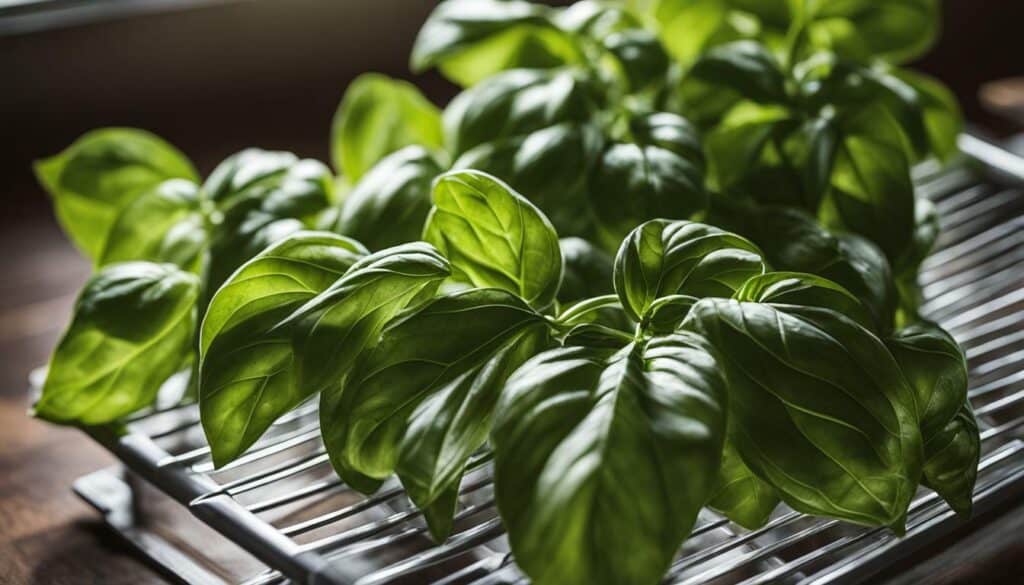
Air Drying Basil
When air drying basil, it’s important to bundle the basil in small bunches to prevent molding and hang them in a well-ventilated area out of direct sunlight. This method is the simplest and most traditional way of drying herbs, and it allows the herbs to retain most of their natural oils and flavors.
Start by selecting healthy basil stems with no signs of wilting or disease. Remove any damaged or yellowing leaves and discard them. Rinse the stems thoroughly under cool water and pat them dry with a clean kitchen towel or paper towel. Avoid washing the leaves themselves as excess moisture can lead to mold growth.
Bundle the basil stems together with a rubber band or piece of twine, making sure the stems are aligned and the leaves are not touching each other. The bundles should be small enough to allow good airflow but not so large that they become too heavy to hang. Place a paper bag loosely over each bundle to catch any fallen leaves.
Hang the bundles of basil upside down in a dry, warm, and well-ventilated area. Avoid direct sunlight as it can cause the basil to lose its flavor and color. The drying time varies depending on the climate and humidity level, but it usually takes about 4-5 days for the basil to be completely dry. The basil should feel crisp and brittle when touched.
Once the basil is dry, remove the leaves from the stems and discard the stems. Store the dried basil leaves in an airtight container in a cool, dark, and dry place. The dried basil can be used in a variety of dishes, such as soups, sauces, and pasta, or brewed into herbal tea for a refreshing and soothing drink.
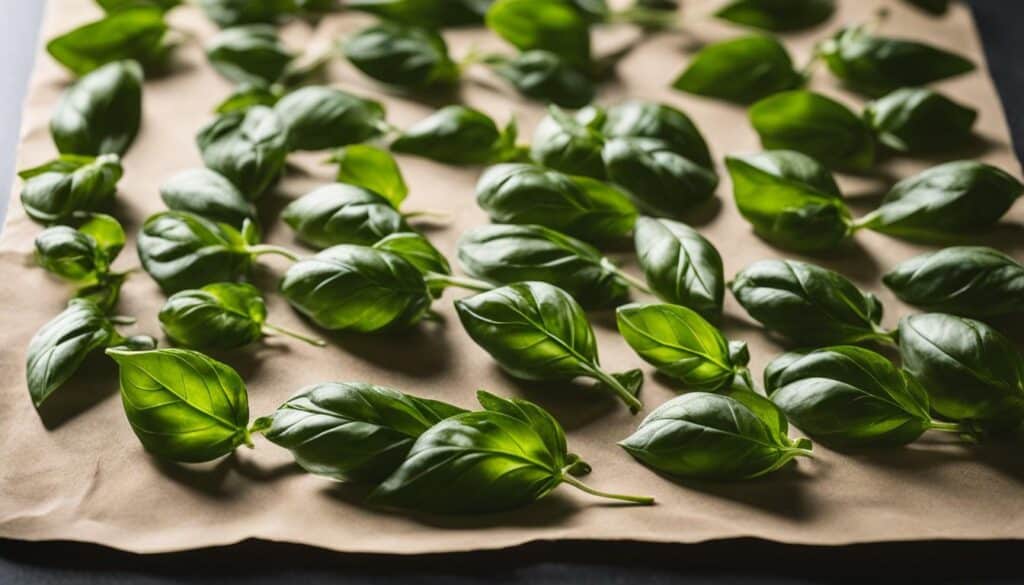
Oven Drying Basil
Oven drying basil is a popular method for preserving this herb for year-round use. Compared to air-drying and using a dehydrator, oven drying is a faster and more efficient way to dry basil leaves.
To oven dry basil, start by preheating the oven to the lowest setting, which is usually around 175°F. Then, spread the basil leaves in a single layer on a parchment-lined baking sheet. Make sure that the leaves are not overlapping each other to ensure even drying.
It may take about 2.5 hours for the basil to fully dry and become crumbly. However, it’s important to check on the basil periodically to prevent burning.
Once dry, the basil leaves can be stored as whole leaves or ground into a powder using a food processor or mortar and pestle. It’s important to store dried basil in an airtight container in a cool, dark place to maintain its flavor.
Dried basil can be used as a substitute for fresh basil in recipes, with 1 tablespoon of fresh herbs equaling about 1 teaspoon of dried herbs. Dried basil can last for at least a year when stored properly.
Other methods for drying basil include air-drying and using a dehydrator. Air-drying basil involves washing the leaves, patting them dry, and hanging them in a cool, dry place for about 4 to 5 weeks. Using a dehydrator involves arranging the basil leaves in a single layer on the dehydrator trays and drying them at the lowest temperature setting for 8 to 24 hours. While microwave drying is the fastest method, it may result in a lesser flavor compared to oven or air-drying.
Overall, oven drying basil strikes a balance between preserving flavor and efficiency. In the oven, spread the basil leaves on a parchment-lined baking sheet and bake at the lowest temperature setting until the leaves are dry and crumbly.
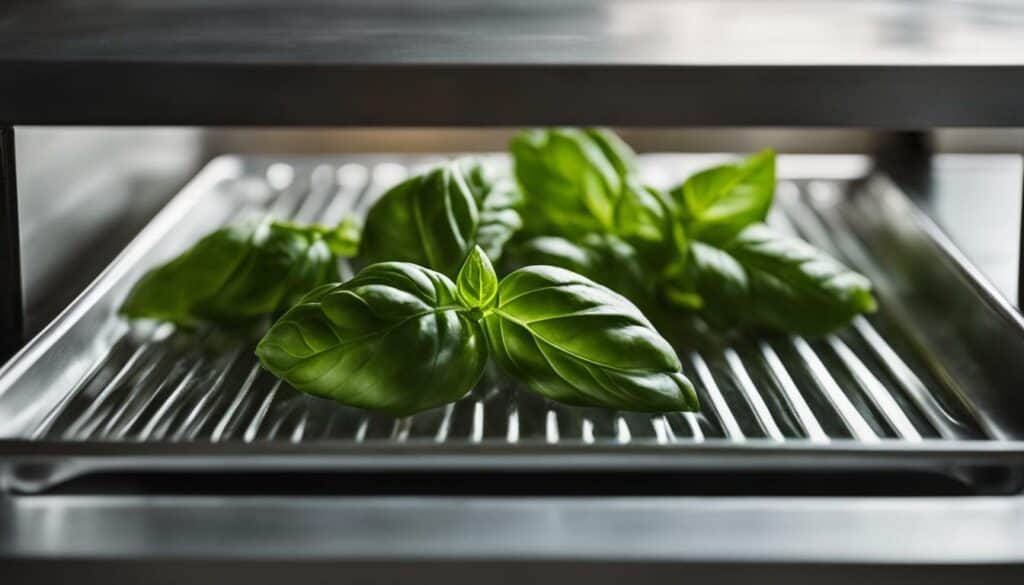
Dehydrating Basil:
Dehydrating basil is one of the easiest methods to dry the herb. It ensures that the basil retains its flavor and aroma, making it a convenient option for those looking to preserve their garden basil for future use.
With a dehydrator, lay the basil leaves on the trays and dry them at a low temperature setting for 4-6 hours. This method is ideal as it ensures that the basil retains its flavor and aroma while removing all the moisture from the leaves.
To ensure the best results, it is recommended to arrange the leaves in a single layer on the trays, leaving sufficient space between each leaf to allow for proper airflow. This will ensure that the basil dries evenly.
Once the basil is fully dehydrated, it should be removed and stored in airtight containers. It is best to store whole leaves rather than crushed or powdered to maximize its flavor.
Dried basil can be used in various dishes, such as soups, pasta sauces, and tomato sauces, to add depth and flavor. It can also be used to make herbal tea.
When it comes to drying herbs, dehydrating basil provides a quick and easy option that ensures the herb retains its flavor and nutritional value.
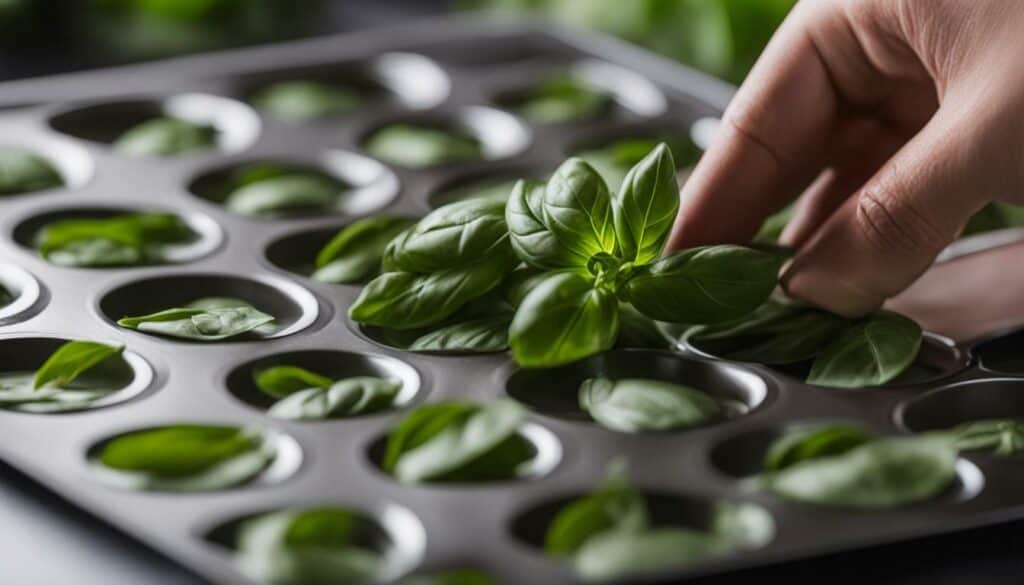
When used properly, dehydrating basil can be an excellent way to preserve the herb for future use. It is an easy process that requires minimal effort and time, making it an ideal option for those with busy schedules.
Storing Dried Basil
Once the basil is fully dry, store it in airtight containers, such as glass jars, in a cool and dark place. Proper storage is key to preserving the flavor and aroma of dried basil. It is recommended to store dried basil as whole leaves, as they will retain their flavor better than crushed leaves.
Avoid storing dried basil in plastic bags or containers, as they may not be airtight and can allow moisture to seep in, causing the basil to spoil quickly. Instead, opt for glass jars with tight-fitting lids or other airtight containers.
Place the dried basil in the jar and seal it tightly. Store the jar in a cool, dark place, such as a pantry or cupboard, away from direct sunlight and heat. Avoid storing dried basil near heat sources like the stove or oven, as well as near windows or other areas exposed to light.
Dried basil can last for up to a year if stored properly. However, it’s important to periodically check the basil for any signs of spoilage or loss of flavor. If you notice any discoloration, unusual texture, or a lack of aroma, it may be time to replace your dried basil.
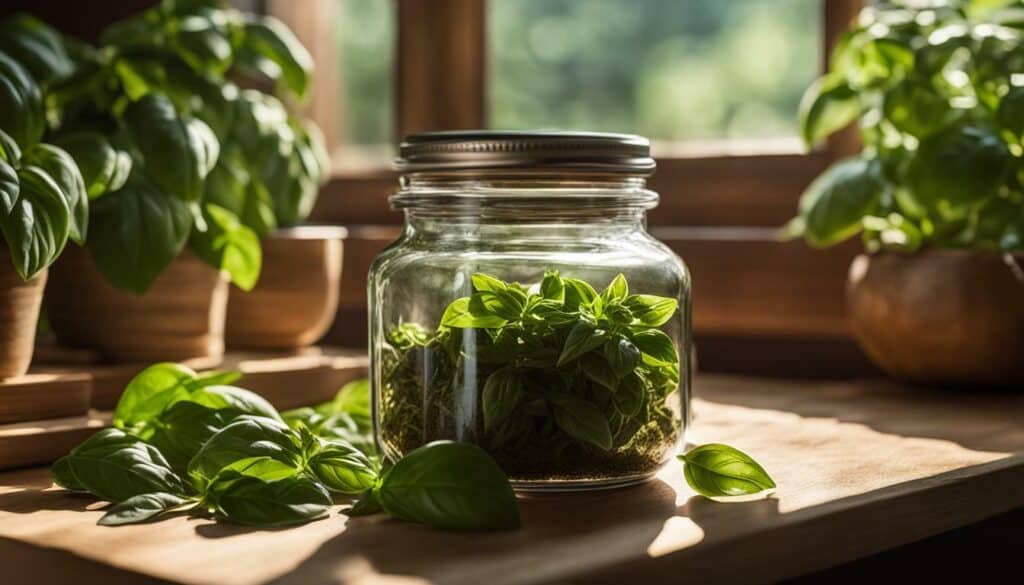
Conclusion:
Properly storing dried basil is essential to preserving its flavor and aroma. Choose airtight containers, such as glass jars, and store the basil in a cool, dark place. With the right storage methods, dried basil can last for up to a year, allowing you to enjoy its delicious flavor and aroma in your cooking year-round.
Benefits of Dried Basil
Dried basil not only helps to preserve the herb but also retains its flavor and aroma, enhancing the taste of various dishes. When compared to the fresh form, dried basil is more concentrated in flavor, making it convenient to use in cooking.
Preserving basil through drying can be done using various methods such as the oven, microwave, or air drying. However, it is important to note that while dried basil can be a flavorful substitute, it is not the same as the fresh form. To preserve the flavor closest to the fresh form, freezing or making and freezing pesto are recommended options.
| Drying Method | Process | Approximate Time |
|---|---|---|
| Oven Drying | Preheat oven to the lowest setting, spread leaves in a single layer on a baking sheet, and bake until dry and crumbly. | 2-4 hours |
| Microwave Drying | Place leaves on a paper towel and microwave for 1-3 minutes until dry. | 1-3 minutes |
| Air Drying | Wash leaves, dry them, and bundle in small bunches. Hang in a cool, dry place out of direct sunlight for several weeks. | 2-4 weeks |
When drying basil in the oven, it is important to preheat it to the lowest setting possible and spread the leaves in a single layer on a baking sheet. Microwave drying is the fastest method, but it can result in a lesser flavor. Air drying basil involves washing the leaves, drying them, and hanging them in a cool, dry place for several weeks.
Dried basil should be stored as whole leaves in an airtight container to maximize flavor and prevent moisture or pests from entering. When substituting dried basil for fresh basil in recipes, it is recommended to use ¼th to ⅓rd of the amount called for. Dried basil can be stored for at least a year in a cool, dark place.
Overall, the benefits of dried basil make it a convenient and flavorful option to enhance various dishes. Whether air drying, oven drying, or using a dehydrator, preserving basil enables it to be enjoyed all year round.
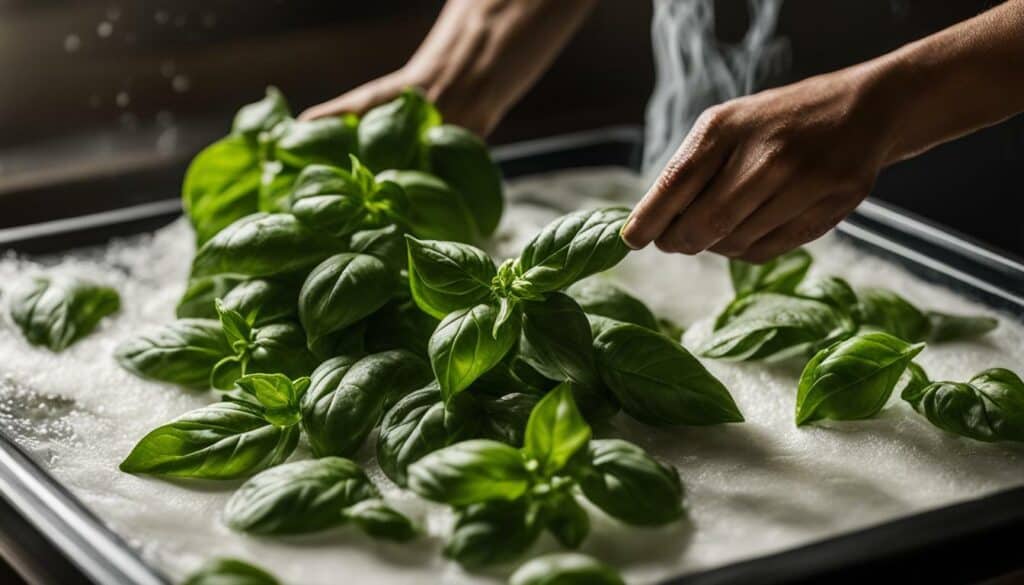
Tips for Successful Drying
To ensure successful drying, it’s important to harvest basil at the right time, clean the leaves, and ensure proper airflow during the drying process. Here are additional tips to help you achieve perfectly dried basil:
- Choose the right method: There are several methods for drying basil, including using the microwave, oven, air drying, or a dehydrator. Consider the time you have, the flavor you want to preserve, and the equipment you have available before selecting a method.
- Harvest at the right time: Basil should be harvested before it starts to flower, as the flavor can become bitter. Use clippers or scissors to gently harvest the basil leaves to avoid bruising.
- Clean the basil: Wash the basil thoroughly to remove any dirt or bugs. Pat the basil dry with a clean towel or use a salad spinner to remove excess moisture.
- Drying basil in the oven: Spread the basil leaves in a single layer on a parchment-lined baking sheet and place it in the oven on the lowest setting (around 175°F). Keep an eye on the leaves to prevent burning and check them after a couple of hours to ensure they are fully dry and crunchy.
- Drying basil in the microwave: Place the basil leaves on a microwave-safe plate between two towels and microwave them in 30-second bursts, checking after each interval until they are dry and shriveled. Note that this method may result in a slightly lesser flavor compared to other drying methods.
- Air drying basil: Tie small bundles of basil stems together and hang them in a cool, dry place with good air circulation. This method may take several weeks for the basil to become fully dry.
- Storing dried basil: Store dried basil in airtight containers, such as glass jars, in a cool and dark place like your pantry. It is best to store the leaves as whole leaves to retain maximum flavor. Crush the leaves just before using them to release the aromatic oils.
- Shelf life of dried basil: Properly stored dried basil can last for at least a year, if not longer. Check for any signs of moisture or discoloration before using older batches.
Remember to experiment with different drying methods to determine the one that works best for you in terms of flavor, convenience, and equipment availability.
Creative Uses for Dried Basil
Dried basil can be used in various creative ways, from making homemade seasoning blends to infusing oils or adding it to soups, stews, and sauces. The strong, fragrant flavor of basil can add depth and complexity to any dish and is a versatile herb that pairs well with many different cuisines.
One creative way to use dried basil is to make your own herb-infused oils. Simply add dried basil to a bottle of olive oil and let it sit for a few weeks, allowing the flavors to meld together. This infused oil can be used for cooking, dressing salads, or as a dip for bread.
Dried basil can also be used to make homemade seasoning blends. Mix dried basil with other dried herbs such as oregano, thyme, and rosemary to create an Italian seasoning blend. This blend can be used to season meats, vegetables, or pasta dishes.
Another way to use dried basil is to add it to soups and stews. Its flavor complements the savory broth and can add an extra layer of depth to the dish. It can also be used to make homemade tomato sauce or added to store-bought sauce for added flavor.
For a refreshing twist, dried basil can be used to make herbal tea. Simply steep the dried leaves in boiling water for a few minutes and strain. The tea can be sweetened with honey or left unsweetened for a more robust flavor.
Aside from its culinary uses, dried basil can also be used in potpourri or as a natural air freshener. The fragrant aroma of basil can freshen up any room and provide a natural alternative to synthetic air fresheners.
Overall, dried basil is a versatile herb that can be used in many creative ways. By experimenting with different recipes and techniques, you can discover new flavor combinations and make the most out of your dried basil preservation methods.
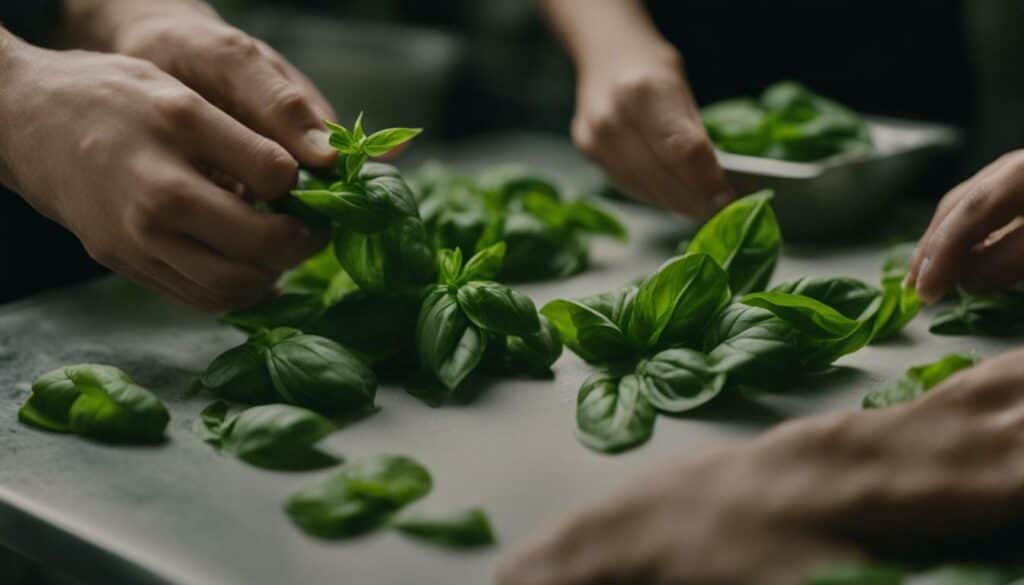
Longevity of Dried Basil
Properly stored dried basil can last for up to a year, with occasional checks for spoilage or flavor loss. It is best to store dried basil in airtight containers or glass jars in a cool, dark place away from sunlight and moisture. This will help ensure its longevity and maintain its flavor and aroma.
It is important to periodically check for any signs of spoilage or loss of flavor. If the dried basil develops mold, off odors, or discoloration, it should be discarded and replaced with fresh dried basil. To prolong the shelf life of dried basil, it is recommended to buy whole leaves and crush them just before use. This will help preserve their flavor and aroma.
Dried basil is a convenient way to preserve this herb for long-term use. It can be used in various dishes, such as soups, stews, sauces, and homemade seasoning blends, adding a depth of flavor and complexity to the dish. Its versatility and ease of use make it a perfect addition to your kitchen pantry.
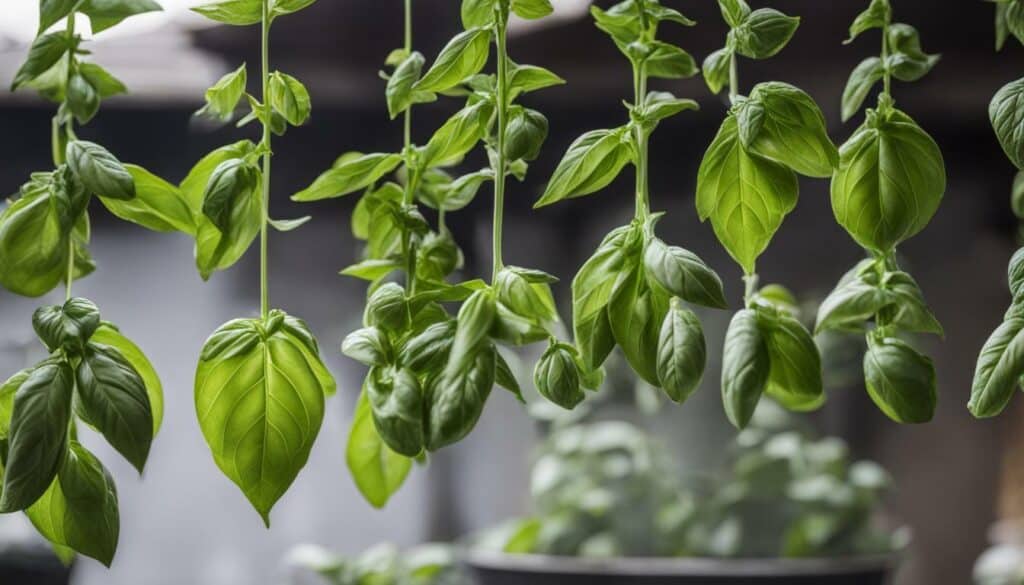
“Dried basil is a great way to preserve the flavor of fresh basil for an extended period,” says Chef John, a culinary expert. I always keep a jar of dried basil in my pantry as a backup option when fresh basil is not available. It is an essential herb that can enhance the taste of any dish.”
What is the Best Method to Store Fresh Basil from the Garden?
The best way to store basil from the garden is by using a sealed plastic bag and keeping it in the refrigerator. Place the fresh basil leaves in the bag, remove excess air, and seal it tightly. Alternatively, you can chop the basil leaves, mix them with olive oil, and freeze them in ice cube trays for convenient use in the future.
Conclusion
Drying basil from your garden is a simple and rewarding process that allows you to preserve the herb’s freshness and enhance the flavors in your dishes. There are several methods to dry basil leaves for long-term use, with the most common being air drying and using an oven or dehydrator.
Air Drying Basil
If air drying basil, bundle the herb in small bunches and hang them in an area with good airflow, away from direct sunlight. It can take 4-5 days for the basil to fully dry in this manner.
Oven Drying Basil
If oven drying basil, spread the leaves out on a baking sheet lined with parchment paper and set the oven to the lowest temperature possible. It may take a couple of rounds of heating and cooling to fully dry the basil.
Dehydrating Basil
For using a dehydrator, lay the basil leaves out on the trays and set the temperature to below 115°F. Once the basil is dry and cooled, it can be stored in a jar for up to a year. It is recommended to store the leaves as whole for better flavor retention.
Regardless of the method used, once the basil is dry and cooled, it can be stored in an airtight container such as a glass jar, in a cool and dry place. Checking periodically for any signs of spoilage or loss of flavor is recommended.
With these methods, you can enjoy the flavor of fresh basil in your dishes all year long. Try drying basil from your garden today and enjoy the benefits of preserving this herb.
FAQ
Q: What are the different methods for drying basil?
A: There are multiple methods you can use to dry basil, including air drying, oven drying, and using a dehydrator.
Q: How long does it take to air dry basil?
A: Air drying basil can take 4-5 days for the basil to fully dry.
Q: How do I air dry basil?
A: Bundle the basil in small bunches to prevent molding, and hang them in a well-ventilated area out of direct sunlight.
Q: How do I oven dry basil?
A: Spread the basil leaves on a parchment-lined baking sheet and bake at the lowest temperature setting until the leaves are dry and crumbly.
Q: How long does it take to dehydrate basil?
A: Drying basil in a dehydrator typically takes 4-6 hours at a low temperature setting.
Q: How do I store dried basil?
A: Store dried basil in airtight containers, such as glass jars, in a cool and dark place.
Q: How long can dried basil last?
A: Properly stored dried basil can last for up to a year.
Q: What are the benefits of dried basil?
A: Dried basil retains its flavor and aroma, making it convenient for enhancing various dishes. It adds depth to different cuisines and is versatile in its use.
Q: Are there any tips for successful drying of basil?
A: Some tips for successful basil drying include harvesting basil at the right time, cleaning the leaves before drying, and ensuring proper airflow during the drying process.
Q: What are some creative uses for dried basil?
A: Dried basil can be used to make homemade seasoning blends, infuse oils, or added to soups, stews, and sauces for enhanced flavors.
Q: How long does dried basil typically last?
A: Properly stored dried basil can last for up to a year, but it’s important to periodically check for any signs of spoilage or loss of flavor.
Source Links
- https://www.schneiderpeeps.com/3-simple-ways-of-drying-basil-at-home/
- https://urbanfarmie.com/how-to-dry-fresh-basil-leaves/
- https://www.homemademastery.com/how-to-dry-basil-leaves/
- https://www.alphafoodie.com/how-to-dry-basil-leaves/
- https://www.instructables.com/How-to-air-dry-basil/
- https://mamaonthehomestead.com/how-to-dry-basil-in-the-oven/
- https://brooklynfarmgirl.com/how-to-dry-basil-in-the-oven/
- https://thekitchengarten.com/how-to-dry-fresh-basil/
- https://homesteadandchill.com/dry-basil-dehydrator-oven/
- https://www.littlehomeinthemaking.com/how-to-dry-basil-dehydrator-or-oven/
- https://rennieorchards.com/how-to-dry-basil-leaves/
- https://www.gardeningknowhow.com/edible/herbs/basil/drying-basil.htm

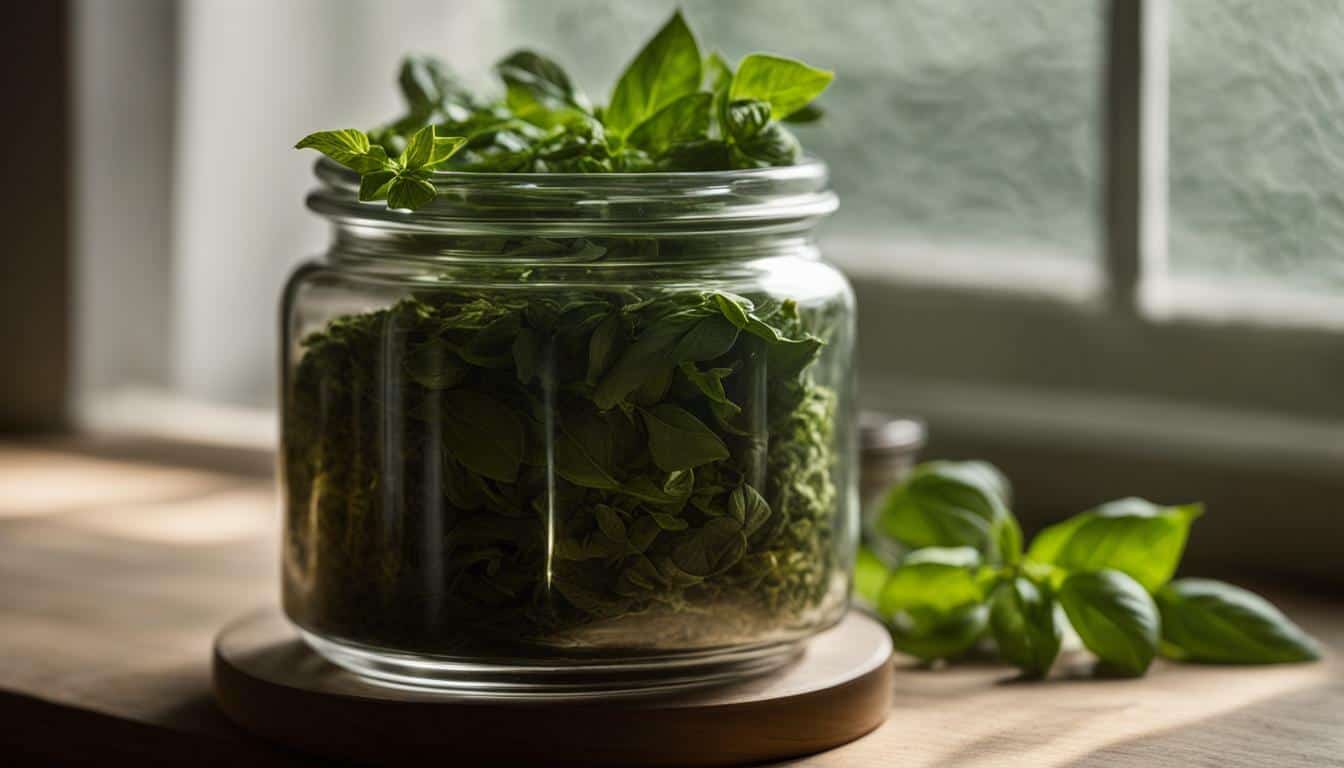



Leave a Reply